
“Montezuma Falls – tallest waterfall in Tassie, 104m drop through the jungle – looks pretty beautiful!”
It was the last day of a month-long climbing and bushwalking trip on the Apple Isle, and my wife Grace and I were looking for a nice short walk to round out an amazing holiday.
I grinned across at Grace. “Why don’t we try and abseil it?”
“Do you do anything like a normal person?”
As we continued our drive up the deserted west coast, I frantically used the last of the phone reception to load up topo maps, satellite images and half a dozen bushwalking forum posts about the area. As hard as I searched, I couldn’t find any info about a track to the top. A look at the map showed why. The falls seemed surrounded by steep-sided, densely vegetated jungle, but I plotted a few potential ridgelines up anyway.
We pulled up at the carpark to some light drizzle, but continued to pack our two 60m ropes, pair of fiddlesticks and various bits and pieces into bags. The rain continued, and when we asked a couple from Queensland returning to their car what the flow was like, their reply of “tonnes of really fast water!” wasn’t overly encouraging.
“Let’s just walk in and check out the falls from the bottom,” I suggested to Grace, who was understandably a bit worried, having never been on an exploratory canyon trip before.
“If it looks dodgy, we’ll just walk back. We’re basically going for a cruisy day hike with too-heavy backpacks!”
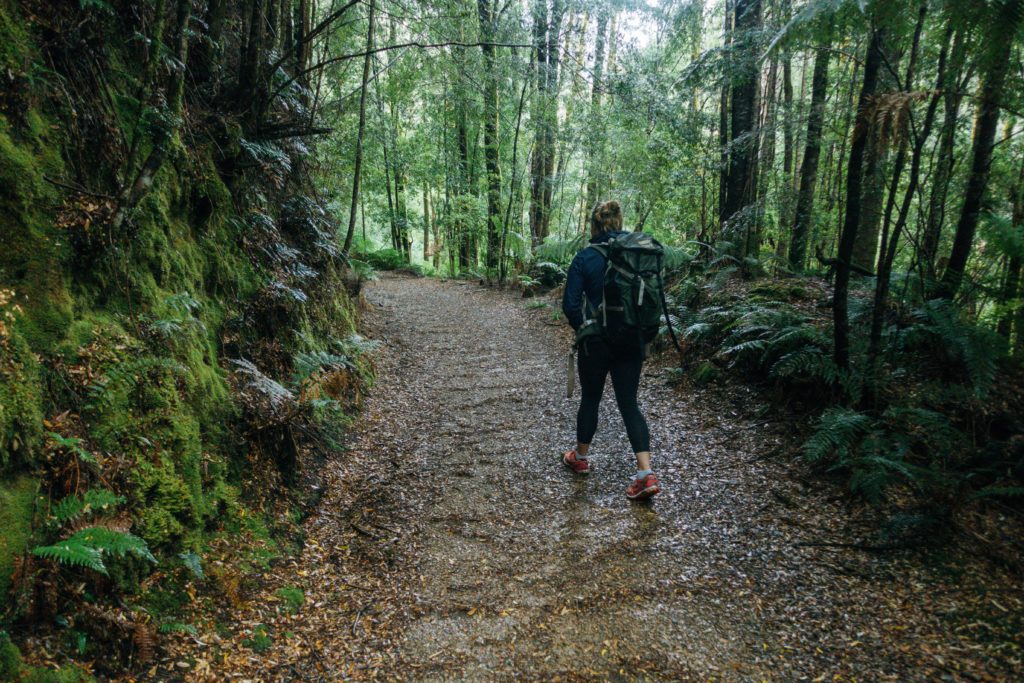
Setting out along the 4km walk to the viewing platform, we found ourselves on an easy, flat firetrail winding through beautiful sub-temperate rain forest. After weeks of trad climbing and off-track walking the tourist track reality felt a bit tame. The path followed an old mining tramline, passing various signs explaining the history of the place that made it worthwhile. There was also an abandoned mine entrance which we quickly checked out with headlamps.

The track eventually opened out to an impressive suspension bridge and viewing platform and excitement mixed with apprehension as we gazed up at the multi-tiered, 104m drop. Over lunch, we chatted to a pair of German nature photographers who promptly decided we were insane.

We farewelled our new, worried friends and headed up the slippery hillside. Any remaining hope of a track quickly dissipated. It didn’t take long to work out that most of the trees were rotten and made terrible handholds, and that almost all of the boulders were barely embedded in the dark, rich soil, meaning a wrong move would send basketball sized missiles careening downhill!
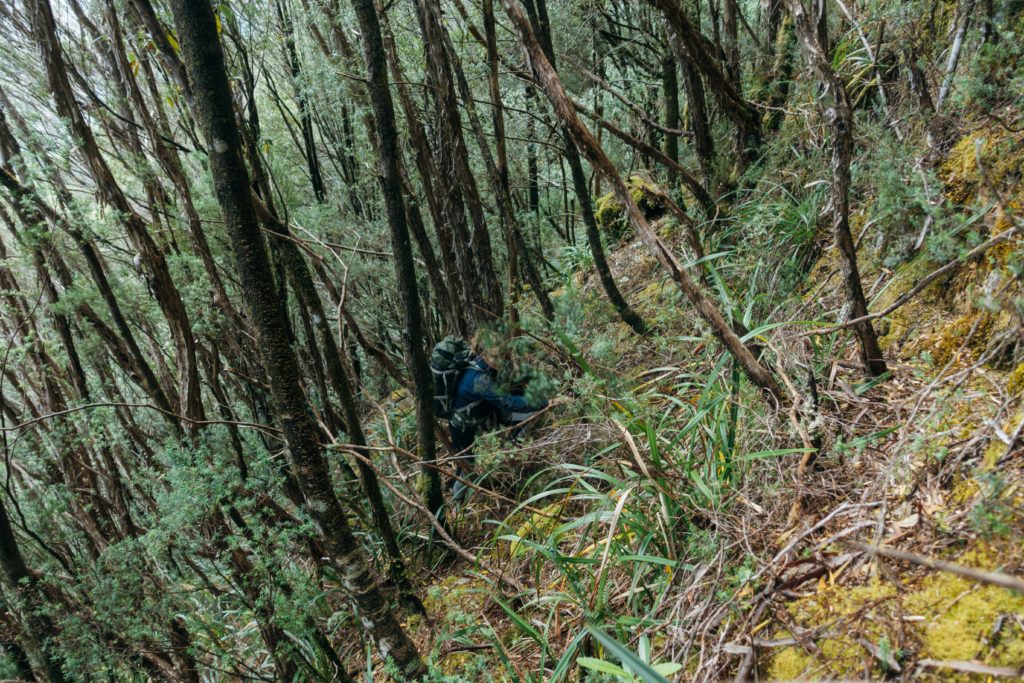
We slowly wound our way up the dodgy ridge back towards the creek, constantly slipping downhill as we attempted to navigate around several cliff bands. I was worried about hitting the falls too early, so kept referring to the LIST topo map on my phone to ensure that we had contoured around enough to drop into the creek well back from the falls.
After an hour and a half of slippery navigation through the dense, steep jungle, it was a huge relief to hear the familiar sound of water and spy a glimpse of the beautiful upper Avon Creek through the gaps in the downed trees. I love this part of exploratory canyoning – knowing that so few people have seen what you’re about to see.
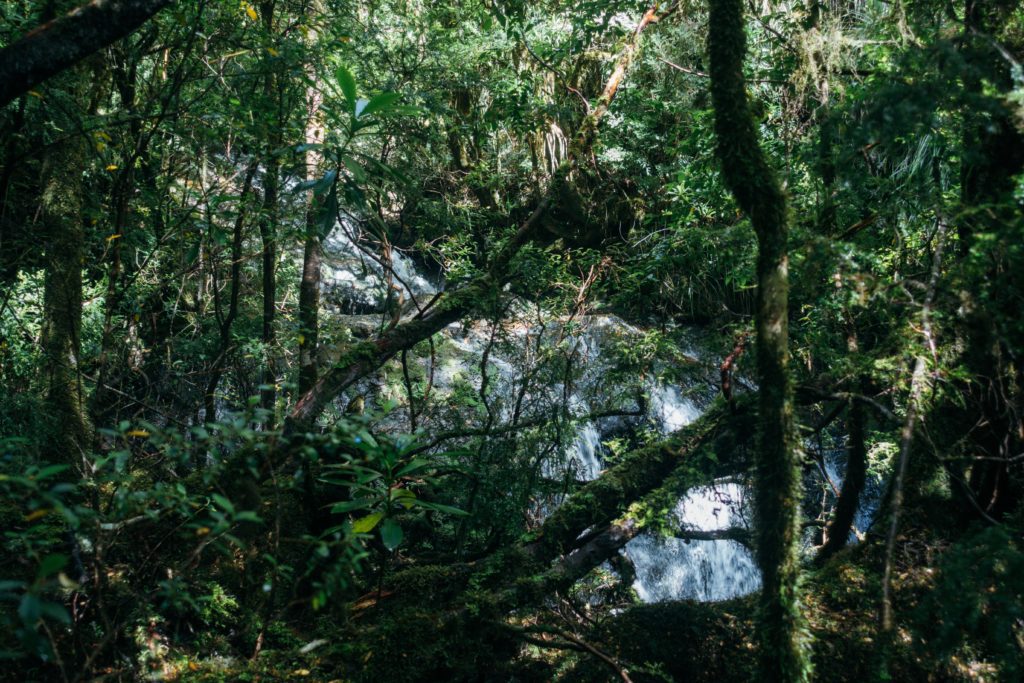

We geared up, not sure of what was to come, and started down the creek towards the falls. At this point, we were 2.5hrs into what was meant to be a brief 3hr, rest day mission. We continued down the beautiful creek, smoothly fiddlesticking solid-looking trees for several 10 to 25m abseils, interspersed with bracing wades. The sides of the hanging valley continued to steepen, and while I was glad that my instincts to drop into the creek well upstream of the falls had been correct, the patchy cloud and gentle fade in and out of drizzle weighed heavily on my mind as our exit options diminished.
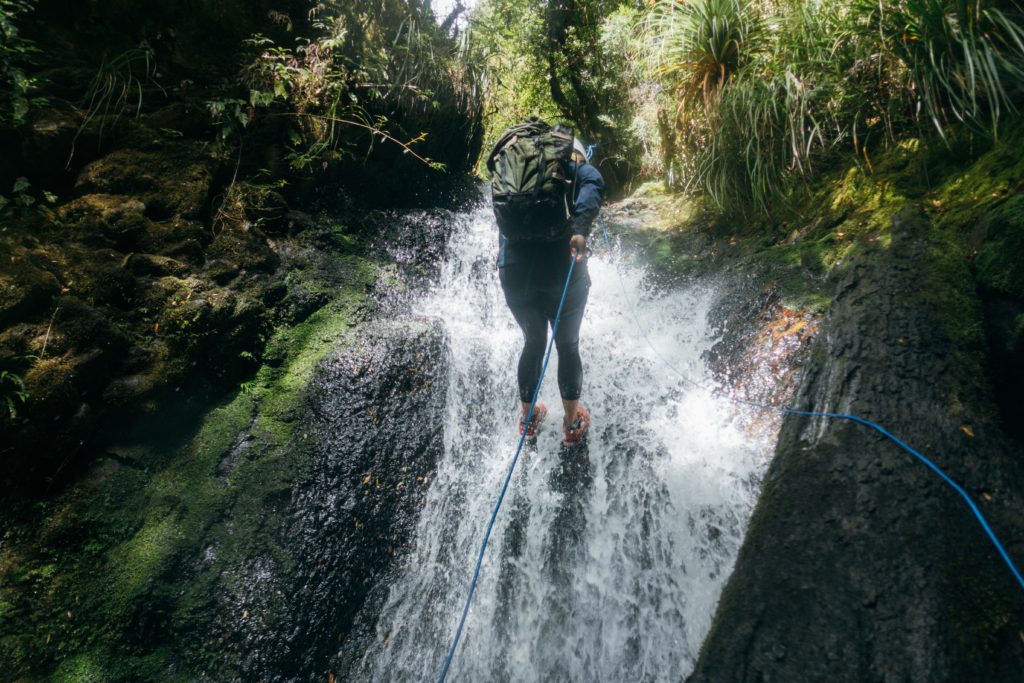

After 500m of canyon, we came to a constricted section with the creek narrowing into a fast-flowing, powerful waterfall of 5m down a rounded edge. The water hammered into a dark, 20m long chute, before pumping off the end down another 10m drop. The deep chasm didn’t seem to have any anchors available — not even cracks for trad gear placements — so I asked Grace to stay up top while I looked at the possibility of combining both drops.
As I went over the edge, chimneying to stay out of the worst of the flow, I slipped and swung forwards. Bracing myself for a body-slam into the wall, to my surprise I went straight through the waterfall, finding myself in a head-height cave that had been completely obscured by the fast-moving water!
Completely saturated and freezing cold, I crossed back out through the waterfall and tried to yell to Grace what to do. She couldn’t hear me over the sound of the flow, and of course when she started down the slippery rock almost exactly the same thing happened! Her scream quickly turned into slightly delirious laughter within the cave. We swam on down the deep, narrow pool, abandoning any hope of staying dry.
As expected, the slot yielded absolutely no anchor options for the following 10m drop, so we scrambled up the scarily mossy cliff until we could find a tree safe enough to abseil back into the canyon.
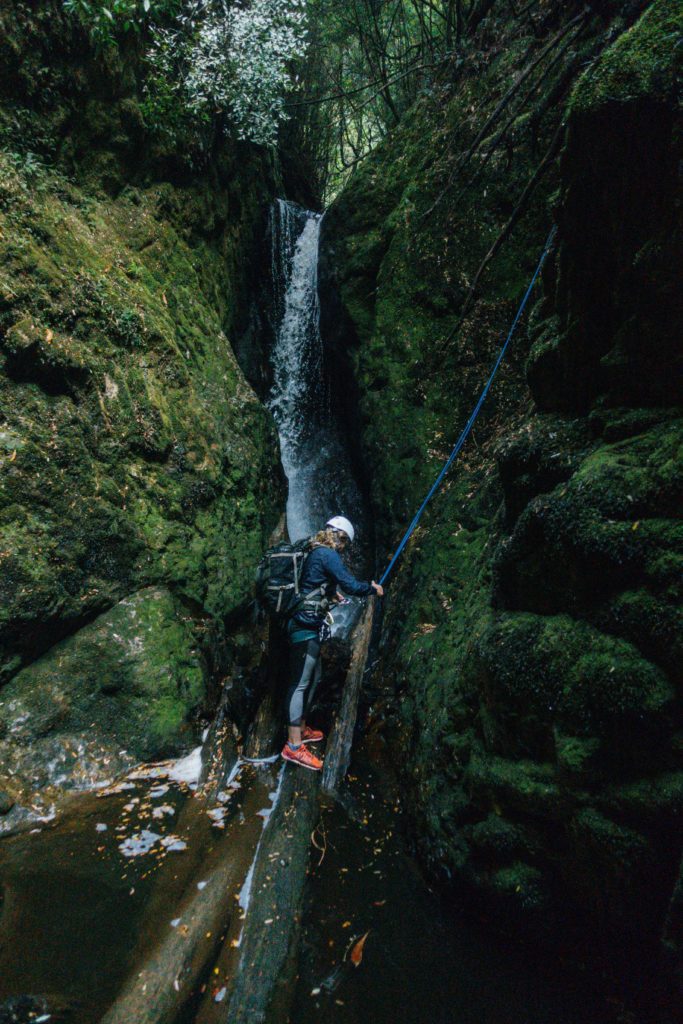
We continued downwards, passing several huge log jams and a number of small waterfalls. There was now noticeably more water chasing us downstream, and with the valley still rising steeply above us on both sides I was starting to seriously regret this trip — all the while pretending to be comfortable and confident for my wife’s sake!

We scrambled as many of the small drops as was safe, finding our rhythm until we finally, finally reached the top of the Falls at 1830 — almost 6hrs after leaving the car!

On rope as a safety line, I carefully peered over the edge of the 75m initial drop, desperately looking for the trees and boulders I had spotted from the bottom of the falls that looked like they would allow a multi-pitch approach. I was prepared to join our two 60m ropes and rig a knot pass, tying the 2 pullcords together to reach the bottom, but I had never tried a knot pass with a fiddlestick before, and 60m down the middle of a pounding waterfall with a further 60m of air below seemed like a terrible place to test it out.
The previously crowded viewing platform and bridge were deserted — clearly all of the tourists were done for the day, worried about walking back in the dark — yet here we were still 104m from freedom!

I spotted a solid-looking, live tree on the right about 50m down and decided to aim for that. Double, triple, quadruple checking the anchor tree and fiddlestick rig, I confirmed our safety whistle and rope tug signals with Grace, then leant back into the void.

The exposure took my breath away, and what little air remained was quickly pounded out of me by the hammering water. Thankfully, while fierce, the falls were fairly narrow, and as I skirted to the right aiming for my second anchor I was able to relax a little — even more so when I saw I’d make it to the tree with a couple of metres of rope to spare!
The tree ledge was big enough to comfortably sit down on, but I rigged up a safety line regardless — one wrong slip and it’d be a quick ride to the bottom. Trying my whistle several times to no response, I tugged on the abseil line and was happy to feel vibrations travelling down 55m of polyester rope that meant Grace was removing the fiddlestick ‘biners and getting ready to abseil.

Joining me on the ledge, we both shivered uncontrollably as I rigged the next abseil. I tried several times to arrange the fiddlestick as I had so many times before, but an awkward starting angle and very low anchor around the base of the tree meant that it was impossible to have the fiddlestick safely suspended in mid-air. I was thoroughly disappointed to have to leave a sling and quicklink in such an otherwise untouched environment — especially such a popular tourist destination — but we concealed it as well as we could and I was soon on my way down twin ropes to the final tier of the falls, aiming for a cluster of fridge-sized boulders that looked like promising anchors.

55m later, I was at the boulders, a mere 30-odd metres above the tourist platform. Grace joined me in the mist without issue, and with difficulty pulled down the rope and re-coiled 120m in the freezing spray, missing the simplicity of the fiddlestick!

Passing several metres of rope around the largest of the boulders, we threaded the rope over and around several notches, trying to avoid a stuck rope at this late stage. I tested the pull down several times to make sure it would work, finally threading the fiddlestick and dropping out of Grace’s sight for the last time.
Arriving at the bottom of the falls, I looked up and could just barely see where we had started from. Grace swiftly followed down the final 35m abseil (Grace: I’m gonna interject here to say that Sid made me pose while only 5m away from freedom, freezing my butt off, to take a photo! Better have been worth it…).
We pulled the fiddlestick, and as the rope and pullcord smoothly bounced down the waterfalls we both let out massive yells and whoops, amazed at having explored such an incredibly beautiful place, but mostly just relieved to be back on solid ground.


We collected our gear, peeled off sodden raincoats and gladly put on the puffer jackets I had stashed at the bottom of the falls. Darkness fell and the rain started in earnest, heavy drops falling on our jackets as we returned along the easy track.
With the roaring of the waterfall fading away, we hiked through the dark jungle, and almost 9 hours after setting out we rounded the corner and saw the welcome sight of our van sitting forlornly alone in the muddy carpark.
We drove 10km into nearby Rosebery in the hope of a hearty pub meal, but of course we were too late for the kitchen… Absolutely exhausted but exhilarated with what we had managed to get away with, we drove into the darkness before parking up for the night in a quiet Devonport carpark, ready to catch the ferry in the morning.
Trip Notes/Reflections…
- I was already convinced by the helpfulness of a fiddlestick, but this trip cemented it in my mind as one of the most versatile canyoning tools available. Combining the fiddle with rope bags meant we were packed and walking away from most abseils before a standard “throw and go” double rope approach would even have finished coiling the rope.
- It’s still worth having a full bag of tricks for anchoring options. “Ghosting” a canyon and leaving no trace is a great ideal to aim for, especially on exploratory trips – but not at the risk of your life. No one deserves to be scraping bodies out of the bottom of waterfalls. Make sure your tape/anchoring material is coloured similarly to the rock – that way if you do have to leave gear behind it’s at least minimally impacting to the scenery. Use high quality tape and stainless steel mallions, so that they’ll be useful for a long time to come.
- I don’t think a full wetsuit is strictly necessary for this kind of trip – the weight penalty on the uphill scramble would have been a pain – but a wetsuit top or even just a second layer of thermals under the Goretex would have been brilliant. Either way, we weren’t prepared for how cold we would get, or how long we would stay cold.
- In hindsight, I’ll never again start an exploratory canyon so late in the day. I didn’t account for the navigation time and how far upstream we would need to go.
- I’ll never again do a trip this committing as a party of 2. We feel fortunate to have got away with this one, but there were so many moments where if something had gone wrong it would have been instantly catastrophic. We had a PLB with us, but help doesn’t come without a wait and any sort of rescue operation would have been risky for a SAR crew. Grace and I are keen to continue learning and practicing our rescue skills for the time we will need them.

A gripping and well written and beautifully photographed account. Well done guys!
Cheers Adrian! It was a stunning place to explore, and I can’t wait to get back down to Tassie to do more.
You crazy kids!